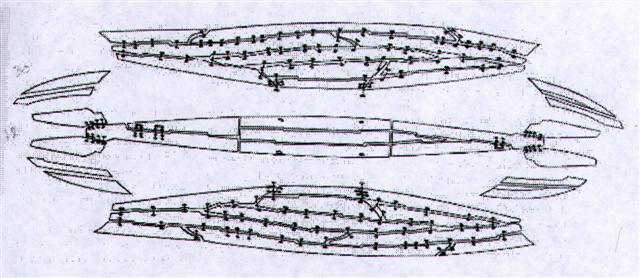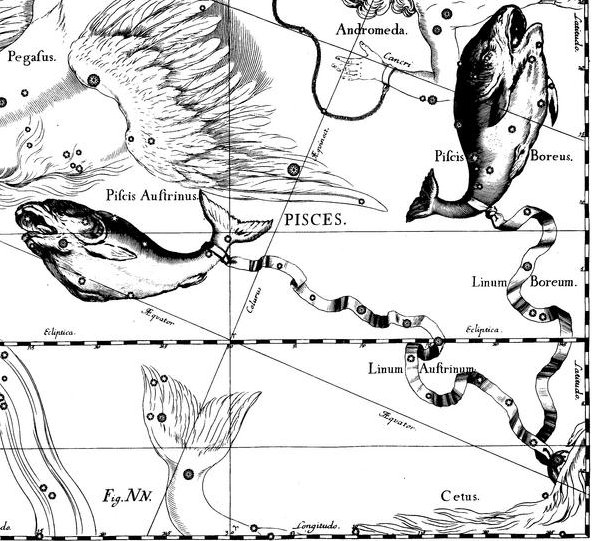167. In my garden the apples are heavy and drawing the branches down, threatening to break them, a consequence of the force of gravity. I could never get used to the idea that on the other side of the earth, down in the southern hemisphere, people were standing upside down. It defied common sense and all experience, it could not be true. It haunted my mind. ... Its representation has generally been as we have it, but the Hyginus of 1488 added a tree in whose branches the Hydra's head is resting; probably a recollection of the dragon that guarded the apple-tree of the Hesperides, although this duty really belonged to our Draco; and at times it has been shown as three-headed ... In my garden the plums have already become ripe and harvested.
... In the inscriptions of Dendera, published by Dümichen, the goddess Hathor is called 'lady of every joy'. For once, Dümichen adds: Literally ... 'the lady of every heart circuit'. This is not to say that the Egyptians had discovered the circulation of the blood. But the determinative sign for 'heart' often figures as the plumb bob at the end of a plumb line coming from a well-known astronomical or surveying device, the merkhet. Evidently, 'heart' is something very specific, as it were the 'center of gravity' ... See Aeg.Wb. 2, pp. 55f. for sign of the heart (ib) as expressing generally 'the middle, the center'. And this may lead in quite another direction. The Arabs preserved a name for Canopus - besides calling the star Kalb at-tai-man ('heart of the south') ... Suhail el-wezn, 'Canopus Ponderosus', the heavy-weighing Canopus, a name promptly declared meaningless by the experts, but which could well have belonged to an archaic system in which Canopus was the weight at the end of the plumb line, as befitted its important position as a heavy star at the South Pole of the 'waters below'. Here is a chain of inferences which might or might not be valid, but it is allowable to test it, and no inference at all would come from the 'lady of every joy'. The line seems to state that Hathor (= Hat Hor, 'House of Horus') 'rules' the revolution of a specific celestial body - whether or not Canopus is alluded to - or, if we can trust the translation 'every', the revolution of all celestial bodies. As concerns the identity of the ruling lady, the greater possibility speaks for Sirius, but Venus cannot be excluded; in Mexico, too, Venus is called 'heart of the earth'. The reader is invited to imagine for himself what many thousands of such pseudo-primitive or poetic interpretations must lead to: a disfigured interpretation of Egyptian intellectual life ... The pears, formed like pregnant women, i.e. with broad Hips (→ Coxa), will soon follow suit (plums → apples → pears). ... When the man, Ulu, returned to his wife from his visit to the temple at Puueo, he said, 'I have heard the voice of the noble Mo'o, and he has told me that tonight, as soon as darkness draws over the sea and the fires of the volcano goddess, Pele, light the clouds over the crater of Mount Kilauea, the black cloth will cover my head. And when the breath has gone from my body and my spirit has departed to the realms of the dead, you are to bury my head carefully near our spring of running water. Plant my heart and entrails near the door of the house. My feet, legs, and arms, hide in the same manner. Then lie down upon the couch where the two of us have reposed so often, listen carefully throughout the night, and do not go forth before the sun has reddened the morning sky. If, in the silence of the night, you should hear noises as of falling leaves and flowers, and afterward as of heavy fruit dropping to the ground, you will know that my prayer has been granted: the life of our little boy will be saved.' And having said that, Ulu fell on his face and died. His wife sang a dirge of lament, but did precisely as she was told, and in the morning she found her house surrounded by a perfect thicket of vegetation. 'Before the door,' we are told in Thomas Thrum's rendition of the legend, 'on the very spot where she had buried her husband's heart, there grew a stately tree covered over with broad, green leaves dripping with dew and shining in the early sunlight, while on the grass lay the ripe, round fruit, where it had fallen from the branches above. And this tree she called Ulu (Breadfruit) in honor of her husband ...
Where can I find the current place of the planet Mars? Should I not rather look for Mercury (Hiro, Hilo) because tonight was equinox - when the night south of the equator was equally long as the night north of the equator. ... Ganz ähnlich is der Name 'Gott von Duazag' des Gottes Nabū ... zu erklären. Er bezeichnet ihn als den Gott des Wachtstums, welches als aus dem Osten stammend betrachtet wird, weil die Sonne, die das Wachstum bringt, im Osten aufgeht. Dass aber Nabū als Ost-Gott aufgefasst wurde, hängt damit zusammen, dass sein Stern, der Mercur, nur im Osten oder Westen sichtbar ist ...
... According to a variety of sources of the legend, the Argo was said to have been planned or constructed with the help of Athena. According to other legends it contained in its prow a magical piece of timber from the sacred forest of Dodona, which could speak and render prophecies. Argo Navis is the only one of the 48 constellations listed by the 2nd century astronomer Ptolemy that is no longer officially recognised as a constellation. It was unwieldy due to its enormous size: were it still considered a single constellation, it would be the largest of all. In 1752, the French astronomer Nicolas Louis de Lacaille subdivided it into Carina (the keel, or the hull, of the ship), Puppis (the poop deck), and Vela (the sails). When Argo Navis was split, its Bayer designations were also split. Carina has the α, β and ε, Vela has γ and δ, Puppis has ζ, and so on. The constellation Pyxis (the mariner's compass) occupies an area which in antiquity was considered part of Argo's mast (called Malus). However, Pyxis is not now considered part of Argo Navis, and its Bayer designations are separate from those of Carina, Puppis and Vela ...
... This is a Tahitian myth telling of how Hiro built his canoe: He cleared the trunks of their branches and bark, hewed them into shape, and with strong fau ropes he and his men drew them down the valley over cliffs and ravines, seeming to feel it merely light work. Thus King Puna was robbed of his fine aha-tea tree, his mara-uri tree, a toi (Alphitonia) tree, and a hauou (pua, Fagraea) tree; and Hiro spared not the trees sacred to the gods around the marae. He cut down a great tamanu (Callophylum), stripped the trunk of its branches and bark, split it up for planks for the bows of his canoe, and trimmed the branches for outriggers and crossbeams. He cut down a most sacred miro (Thespesia) tree for planks for the after part of his canoe, and he took two tall straight breadfruit trees for planks for the deck houses. Then he went into the woods and cut down straight fau trees (Hibiscus tiliaceus) for paddles and for floor planks, and three slim hutu (Barringtonia) trees for masts. After all this depredation, Hiro and his men helped themselves to wood and thatch and reeds and all other material needed for a shed in which to build the canoe and for rollers to place under it, King Puna not daring to oppose them, as Hiro was too powerful and dangerous to vex ... Amid all the required ceremonies and prayers and good omens, they set to work. On rising ground they erected a great shed thirty fathoms long, six wide, and five fathoms high, facing the sea endwise. The builders had their baskets of axes and adzes of stone, gimlets of coconut and sea shells, and sennit of fine tight strands, prepared and consecrated to the god Tane for this special purpose. Hiro marked out the keel, the knees, the beams, and the planks, and the men cut them into shape. All the material for the work was carefully sorted and handily placed in the shed, Hiro passing it to the men as they required it ... They set the keel of avai, toi, and mara wood, polished and firmly spliced together with hard spikes of wood secured with sennit, upon rollers in the shed and painted it with red clay mixed with charcoal so as to preserve it from wood borers. Then they fastened the knees onto the keel with spikes and sennit. Holes were bored into the keel and planks at even distances apart, and the men set to work in the following order: Hotu, the chief of Hiro's artisans, worked on the outer side to the right of the canoe, and Tau-mariari, his assistant, worked on the inner side; Memeru, the royal artisan of Opoa, worked on the outer side to the left of the canoe, and his assistant, Ma'i-hae, worked on the inner side. Each couple faced each other, fixing the planks in their places and drawing the sennit in and out in lacing the wood together; and the canoe soon began to assume form, the bows facing the sea. To make work light they sang ... Every seam and all the little holes in the wood from the keel and upwards were well caulked with fine coconut-husk fiber and pitched carefully with gum, which Hiro drew from sacred breadfruit trees of the marae, and when all the streaks were on the canoe was washed out clean and dried well and painted inside and outside with red clay and charcoal. As the hull of the canoe reached almost to the roof, the builders could work no longer within the shed, and so they broke it away. Then the boards of the deck were set upon the beams and fixed in place with spikes and sennit, and the ama or outrigger of tamanu wood, which had been well steeped in water to preserve it from borers, was polished with limestone and firmly lashed with sennit on to the left side of the canoe, the upper attachment of wood forming across each end of the canoe a beam, called 'iato, and lashed on to the right side in the same manner as on the left side ... Next came the finely carved towering ornaments for a reimua (neck-in-front, the figurehead) and a rei muri (neck-behind, stern ornament), which were fastened on to their respective places, and they were named Rei-fa'aapiapi-fare (Necks-filling-up-the-house), because the shed was broken away to allow placing them and finishing the canoe. The two deck houses, called oa mua and oa muri (fore house and aft house), were then set in their places and thatched with fara leaves, after which Hotu, the chief artisan, cut out the holes in the deck and down in the keel, in which he stood the three masts, before mentioned, which had been steeped in water, well seasoned, dried, and polished. The canoe was completed. Hiro dedicated it to Tane, naming it Hohoio (Interloper) … Finally the day arrived for launching the canoe, and a great multitude assembled to see the wonderful sight. The props were removed from the sides of the canoe, and the men held it ready to launch over the rollers. Hotu invoked the gods Ta'aroa, Tane, 'Oro, Ra'a, Ro'o, and Moe, to their aid, and soon their presence was felt impelling the canoe. The rollers began to move, and then the canoe went forwards, slowly at first as the men's hands steadied it and then swiftly and well poised as it gracefully descended alone and sat upon the sea, which rose in great rolling waves caused by a wind sent to meet it by the aster Ana-mua (Antares in Scorpio), the parent pillar of the sky. The spectators greatly admired Hiro's ship and raised deafening shouts. Then the canoe was made to drink salt water; it was dipped forwards and backwards in the waves of the great moving altar of the gods and thus consecrated to Tane. A marae was made for him in the little house aft of the deck, and the three masts were rigged with ropes and strong mats for sails and long tapa pennants streaming from them ... Within a few days the canoe was loaded with provisions. Great fish baskets were made of bamboo, filled with many kinds of fish, and attached to the outside of the canoe so as to be in the water. Bamboos and gourds were filled with water and stowed away on board, and there were fe'i, bananas, taro, and mahi (fermented breadfruit) in abundance. A bed of sand and stones was made upon the deck, upon which to make a fire for cooking the food, and soon Hiro was ready to go to sea. Hiro was the captain and pilot, and he had other competent seamen, who like him were acquainted with the heavenly bodies and their rising and setting. Women and children also accompanied their husbands and fathers on board, and on one fine day, with a strong favorable wind, they set sail, applauded by many spectators, among whom were prisoners of war (called tîtî), whose shouts were heard above all others. They saw Hiro's great pahi sail out to sea and disappear beyond the horizon, never again to return to Tahitian shores ...
I decided to begin a month previously, i.e. a year after August 23 AD 2022 where we have found the current start for a cycle of the retrograde motion of Mars:
Here we (in August 23 AD 2023) can see Mars at β Virginis with Mecury coming not much later (and just below the equator). Venus is above the head of the Hydra. According to my old astronomy book the Arabs saw β (Al-Araph, The Unarmed) ... Zayin (also spelled Zain or Zayn or simply Zay) is the seventh letter of many Semitic abjads ... It represents the sound [z]. The Phoenician letter appears to be named after a sword or other weapon. (In Biblical Hebrew, 'Zayin' means sword, and the verb 'Lezayen' means to arm. In modern Hebrew, 'zayin' means penis and 'lezayen' is a vulgar term which generally means to perform sexual intercourse and is used in a similar fashion to the English word fuck, although the older meaning survives in 'maavak mezuyan' (armed struggle) and 'beton mezuyan' (armed, i.e., reinforced concrete). The Proto-Sinaitic glyph according to Brian Colless may have been called ziqq, based on a hieroglyph depicting a 'manacle' ... as the place in Virgo where Moon would have its strongest influence (on people who were born in the sign of Virgo).
And, as we have found out earlier, β Leonis (Deneb-Ora → Tail of Sun Life) was practically at the same place:
... In other words, the ancient Druidic religion based on the oak-cult will be swept away by Christianity and the door - the god Llyr - will languish forgotten in the Castle of Arianrhod, the Corona Borealis. This helps us to understand the relationship at Rome of Janus and the White Goddess Cardea who is ... the Goddess of Hinges who came to Rome from Alba Longa. She was the hinge on which the year swung - the ancient Latin, not the Etruscan year - and her importance as such is recorded in the Latin adjective cardinalis - as we say in English 'of cardinal importance - which was also applied to the four main winds; for winds were considered as under the sole direction of the Great Goddess until Classical times ... ... Gronw Pebyr, who figures as the lord of Penllyn - 'Lord of the Lake' - which was also the title of Tegid Voel, Cerridwen's husband, is really Llew's twin and tanist ... Gronw reigns during the second half of the year, after Llew's sacrificial murder; and the weary stag whom he kills and flays outside Llew's castle stands for Llew himself (a 'stag of seven fights'). This constant shift in symbolic values makes the allegory difficult for the prose-minded reader to follow, but to the poet who remembers the fate of the pastoral Hercules the sense is clear: after despatching Llew with the dart hurled at him from Bryn Kyvergyr, Gronw flays him, cuts him to pieces and distributes the pieces among his merry-men. The clue is given in the phrase 'baiting his dogs'. Math had similarly made a stag of his rival Gilvaethwy, earlier in the story. It seems likely that Llew's mediaeval successor, Red Robin Hood, was also once worshipped as a stag. His presence at the Abbot's Bromley Horn Dance would be difficult to account for otherwise, and stag's horn moss is sometimes called Robin Hood's Hatband. In May, the stag puts on his red summer coat. Llew visits the Castle of Arianrhod in a coracle of weed and sedge. The coracle is the same old harvest basket in which nearly every antique Sun-god makes his New Year voyage; and the virgin princess, his mother, is always waiting to greet him on the bank ...
... The Latins called this Porrima, or Antevorta, sometimes Postvorta, names of two ancient goddesses of prophecy, sisters and assistants of Carmenta or Carmentis, worshiped and at times invoked by their women. Porrima was known as Prorsa and Prosa by Aulus Gellius of our 2d century. γ [Virginis, *191.5] was specially mentioned by Kazwini as itself being Zāwiat al 'Awwā', the Angle, or Corner, of the Barker; and Al Tizini, with Ulug Beg, had much the same name for it; but Al Bīrūnī, qouting from Al Zajjāj, said 'these people are all wrong', and that 'Awwā' here meant 'Turn', referring to the turn, or bend, in the line of stars ...
... The swinging doors theme, which is found all the world over, belongs most certainly to the oldest mythic tradition known to man. The same is probably true of the swing, around which the American Indians built up a whole mythology ...; swings existed in real life, particularly among the Salish, whose various dialects distinguished between the cradle-swing - 'suspended from a long thin pole stuck in the ground and the upper end bent over ... the weight of the child being sufficient ... to allow the cradle to swing gently up and down with the movements of the child, which were kept up by a cord attached to the cradle and given to the mother or one of the old women of the household to pull from time to time' ... ... and the seat swing, which at least among certain groups had a ceremonial or ritual use, reserved, it would seem, for adult women ...
|
|||||||||||||||||||||||||||||||||||||||||||||||||||||||||||||||||||||||||||||||||||||||||||||||||||||||||||||||||||||||||||||||||||||||||||||||||||||||||||||||||||||||||||||||||||||||||||||||||













.jpg)


